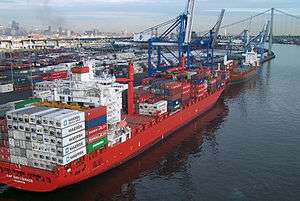Port of Philadelphia
| Port of Philadelphia | |
|---|---|
 | |
| Location | |
| Country | United States |
| Location | Philadelphia |
| Details | |
| Operated by | Philadelphia Regional Port Authority |
| Owned by | Pennsylvania |
| Statistics | |
| Draft depth | 40 feet |
| Air draft | 174 feet, restricted by Delaware Memorial Bridge |
|
Website philaport | |
| Public authority overview | |
|---|---|
| Formed | July 10, 1989 |
| Jurisdiction | Pennsylvania |
| Public authority executive |
|
| Key document |
|
| Website |
philaport |
The Port of Philadelphia, within the municipal boundaries of Philadelphia, Pennsylvania is located near the navigable end of the Delaware River. Port facilities are serviced by three Class I railroads: CP Rail, CSX, and Norfolk Southern and provide service to major eastern Canadian points as well as midwestern, southern and southeastern U.S. destinations. Terminal facilities are located in close proximity to I-95 and I-76, and over 400 local trucking companies operate in the region, with a combined total of over 20,000 trucks. Along with the Port of Camden, across the river in Camden, New Jersey, it falls under the jurisdiction of the Delaware River Port Authority.
Terminals
The Port consists of a series of marine terminals, each with specialized capabilities. The 112-acre (0.45 km2) Packer Marine Terminal handles containers, steel products, frozen meat, fruit, heavy lift projects, and paper. The 116-acre (0.47 km2) Tioga Marine Terminal is home to Philadelphia’s Chilean fruit business and also handles containers, breakbulk cargo, and steel. Pier 84 is a dedicated cocoa products facility. Five piers, including Piers 38, 40, 78, and 80 comprise the Port's forest products center, handling newsprint, wood pulp, lumber, coated paper, and other forest products.
Shipping
The Port of Philadelphia handles a large amount of containerized traffic, ranking as of 2007 as the 23rd-busiest U.S. port by container volume (following Gulfport, Mississippi, the 22nd-busiest port).[1] The port in 2007 handled 167,413 twenty-foot equivalent units (TEU) compared with the busiest U.S. port, the Port of Los Angeles, which handled 5,496,716 TEU, over thirty times more volume, the same year.[2] While not listed in a world ranking of ports by container traffic, based on the volume shipped through Philadelphia, it would rank well below the top 100, as the 100th busiest port, Damietta in Egypt, handled 894,000 TEUs, more than five times the number of TEUs as Philadelphia[3]
In terms of cargo tonnage, the port in 2007 ranked 24th behind Pascagoula, Mississippi under that measure of activity.[4] The port in 2007 handled 35.1 million tons of cargo compared to the busiest U.S. port by tonnage, the port of South Louisiana, which handled 229 million tons, over six times the tonnage of Philadelphia, the same year.[5] While not listed in a world ranking of ports by tonnage, based on the tonnage shipped through Philadelphia it would rank as approximately the 120th busiest port in the world.[6]
The port itself claims the ranking of the #1 perishables port in the United States. The combined ports along the Delaware River, which include Philadelphia and Wilmington together, rank #3 in the U.S. for steel imports, and are among the United States' key entry points for forest products and for cocoa.[7]
The United States federal 2013 fiscal budget confirmed that funds would go towards the dredging of the Delaware River from 40 to 45 feet.[8] This would give larger container vessels access to the Port of Philadelphia. The dredging coincides with the widening of the Panama Canal, and the expected increase in traffic was cited as one key reason in the funding of the dredging project. In light of this the state of Pennsylvania has embarked on a major expansion of the Port of Philadelphia. In 2009 Governor Ed Rendell dedicated $25 million to the Southport expansion project and specified two teams:
- a consortium of Delaware River Stevedores (consisting of Carrix Inc. and Ports America Group) and of Hyundai Merchant Marine America
- SMT Development Partners
as the groups involved in the construction and operation of the new facilities.[9]
Cruise Ships
The cruise terminal closed in 2011.[10]
The port was served by two cruise lines: Royal Caribbean International and Norwegian Cruise Line, although both lines had more frequent sailings out of the port of Baltimore, which is closer to the outlet for the Atlantic Ocean, and enables ships to reach international waters (and therefore open their casinos) more quickly than when sailing from Philadelphia.
The fact that Pennsylvania is defined as not having a seacoast under U.S. Department of Commerce concepts could be considered to make Philadelphia one of the largest fresh water ports in the world, although the Delaware River is tidal as far as Trenton.
History
The Philadelphia Regional Port Authority was created by the Philadelphia Regional Port Authority Act (enacted July 10, 1989; P.L. 291, Act No. 50 of 1989; ch. 17H).
See also
References
- ↑ U.S. Army Corps of Engineers U.S. Waterborne Container Traffic by Port/Waterway in 2007
- ↑ US Army Corps of Engineers U.S. Waterborne Container Traffic by Port/Waterway in 2007
- ↑ AAPA World Port Rankings
- ↑ US Army Corps of Engineers U.S. Waterborne Tonnage for Selected U.S. Ports in 2007
- ↑ US Army Corps of Engineers U.S. Waterborne Tonnage for Selected U.S. Ports in 2007
- ↑ AAPA World Port Rankings
- ↑ http://www.philaport.com/marketing/brochure2008.pdf Port of Philadelphia 2008 Brochure
- ↑ http://www.philly.com/philly/business/20120213_Budget_money_for_Delaware_River_dredging_is_confirmed.html?cmpid=124488459
- ↑ http://www.marinelog.com/DOCS/NEWSMMIX/2010jul00261.html
- ↑ The final page from cruisephilly.com
External links
- US Harbors Tides Philadelphia
- Philadelphia Regional Port Authority (Official Website)
- (Philadelphia Regional Port Authority presentation)
Coordinates: 39°55′6.1″N 75°8′11.8″W / 39.918361°N 75.136611°W